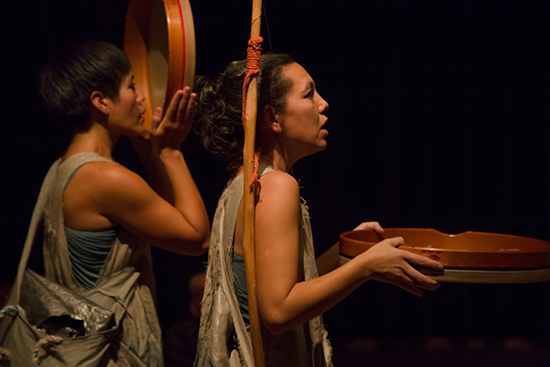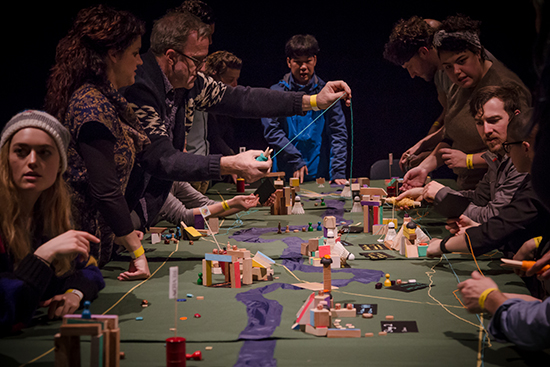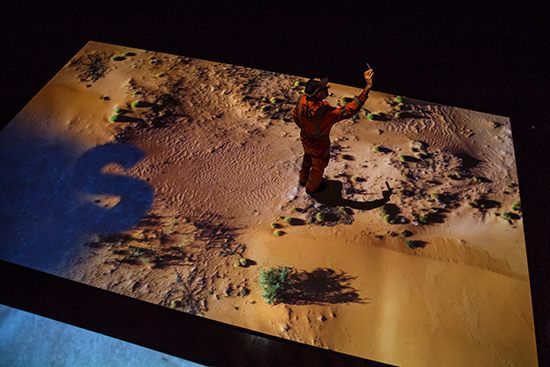Thought-shifting art
Andrew Fuhrmann: Performing Climates

Enfold
The arts have always provided a mirror on our relationship with the environment. The epic poems of the ancient world in which heroes sailed forth to do battle with terrifying monsters in unmapped regions register culturally specific ways of thinking about nature, its concealed resources and potential transformations. This is also true of the cave paintings at Lascaux and Aaron Copland’s Appalachian Spring, for the landscape paintings of Li Cheng and Jane Campion’s Top of the Lake.
But is the ancient role of sensitive and receptive observer enough in an age when we are beginning to feel the impacts of anthropogenic climate change? For many artists, the answer is no. Today’s issues are too important. There is a feeling in the air that now more than ever the artist must make a conscious effort to be useful, to be the hammer and not the glass, to advocate for collective global action on emissions management and to warn of the dangers of failing to act.
And so artists—with plenty of support from arts and other organisations around the world—are increasingly looking to new methods of performance that prioritise community participation and aim to shift cultural attitudes.

Best Festival Ever
The Best Festival Ever
This seems to be the motivating impulse behind a short program of events curated by Arts House and presented as part of the 2016 Performance Studies International Conference at the University of Melbourne.
In an attempt to convince audiences of the everyday utility of the interdisciplinary field of systems science, David Finnigan, Nathan Harrison, Nikki Kennedy, Rachel Roberts and David Shaw (going under the name Boho Interactive) have created a participatory performance event based on a series of tabletop games.
In Best Festival Ever, audience members play the role of music festival organiser, following a kind of choose-your-own-adventure storyline inspired by some of the great music festival disasters, including the floods at the infamous 2005 Glastonbury Festival. All the while Boho Interactive cannily sneaks in quick lessons on the basic principles of systemology.
The set-up is very attractive. We sit at a long table covered in green cloth with a model stage at one end and a serpentine strip of blue running down the centre representing a creek at the festival location. The games involve coloured building blocks, dice, toy quadbikes and lots of negotiations. There’s a charming homemade quality to the props, but it all works smoothly and the evening hums along. The apt use of Captain Planet figurines gives me a special sentimental thrill.
It is hard to judge the pedagogical value of the show. If it’s any measure of success or failure, I’m not sure that I gleaned enough to go out myself and preach the importance of tipping points or hysteresis or whatever. However, as a social event, it is brilliant fun and consistently involving. It’s no surprise that Best Festival Ever has had success as a team-building exercise with corporate clients both in Australia and in England.
The show has an optimistic spirit and an ultimately comforting message, reassuring us that science provides the conceptual tools needed to manage environmental disasters, even those of immense complexity, as long as there are enough people at the table.
Enfold
In Enfold, a meditative installation and dance piece by Ria Soemardjo, Jade Dewi Tyas Tunggal and Paula Van Beek, we shift to a different model of participation. If there is a sort of creeping philistinism about Best Festival Ever in the way it reduces art to mere communication, Enfold heads in the other direction, insisting on the connection between art and the sacred.
Enfold attempts to engineer a sense of participation and flow by moving the audience around the space as the performance shifts from one corner to another, using a few small props to indicate a shifting shoreline. At different points we are given small cup-like structures made from a kind of crude felt, about the size and shape of an oyster shell. With these we are invited to carry water with us while we watch.
Vocalist Soemardjo sings a brief but haunting arietta that sounds like a disappearing lullaby while Tyas Tunggal improvises from fragments of traditional Javanese dance, undulant and slowly vibrating. The two performers, who previously collaborated on the very impressive and highly atmospheric Opal Vapour (2012), often touch throughout early parts of the performance, resting on one another, as if connected by a shared breath. Later, Soemardjo accompanies herself with a single-string Brazilian percussion instrument called a berimbau while Tyas Tunggal cruises around the space wearing a small square of plastic tarpaulin as a wrap. Much of this work feels like the eroded remnant of some larger symbolism.
The show is performed in a small room upstairs at the North Melbourne Town Hall. It’s such a stripped down presentation that I had a strong feeling that we really were in an out-of-the-way place, caught on the inside of a fold. The narrow dimensions, hard walls and the absence of furnishings in the room give Soemardjo’s voice a pleasing fullness and depth.
The idea is to create a mobile ceremony that can be adapted to different kinds of venue. Rituals require that participants understand the steps, or are initiated; here there always seemed to be some confusion about where to stand and when to move, which prevented our complete immersion in the experience. There were lots of nods and puzzled smiles and misunderstandings as Janette Hoe, a dance artist in her own right but here playing a kind of usher, attempted to shepherd audience members around the space.

And the earth sighed, Josephine Starrs, Leon Cmielewski
and the earth sighed
A large video installation, titled and the earth sighed, represents a more confrontational and in many ways problematic approach to the performance of climate. It features footage of Australian landscapes and seascapes recorded by drones and underwater cameras projected onto the floor of the main performance space at the North Melbourne Town Hall. Entering the space from above, via a scaffold platform, we stare down as the land is subjected to post-production manipulations, showing encroaching sea water and desertification.
And there is text, too, digitally scrawled across the land, erasing the kangaroo tracks and wild flowers. In a brief catalogue essay, Fiona McGregor asks how one can empathise with an environment. Josephine Starrs and Leon Cmielewski seem to suggest that the way to do this is to subject the environment to a recognisably human torture. Their defacement of the desert echoes the punishment described by Kafka in a short story, “In the Penal Colony,” in which prisoners’ sentences are carved onto their bodies. It’s as if humanity is a machine with which to judge and then destroy the Earth.
Even without these dynamic manipulations, the work manages to create an atmosphere of menace. With the camera looking down, the shadow of the quadcopter drone is always visible, gliding over the landscape. It looks like crosshairs and feels like the artists are targeting the Earth. The projections are arranged so that the audience can wander across the images, as if traversing the land; but when I visited, no one seemed game, preferring to observe from a safe distance. Who would willingly place themselves in the crosshairs, especially when the pilot seems so callow and unstable?
In contrast to other pieces in the Performing Climates program, which includes Marrugeku’s Cut the Sky, this is a work that seems to encourage a kind of inhibitory fear of the new climatic regime. And the earth sighed suggests that the threat is ineluctable and that action is pointless: all that we can do is record our doom-struck fascination with the planet’s coming transformation.
–
Performing Climates, Arts House, North Melbourne Town Hall; 6-10 July
RealTime issue #133 June-July 2016






